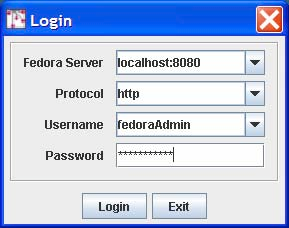Page History
...
Figure 1 - Fedora repository as mediator for services and content
Figure 2 - Fedora Administrator Login Screen
Figure 3 - New object dialog
Figure 4 - Configuring an object
Figure 5 - Datastream display
Figure 6 - Adding a new managed content datastream
Figure 7 - Complete datastreams for example 1
Figure 8 - Example 1 digital object and datastreams
Figure 9 - Adding a datastream with type Redirect
Figure 10 - Example 2 datastream display
Figure 11 - Example digital object and redirected datastream
Figure 12 - Abstract View: Key Fedora Components for Producing Disseminations of Content
Figure 13 - Relationships between Data objects and CModel/SDef/SDep objects for CMA
Figure 14 - Dynamic dissemination access
Figure 15 - Example 3 Linking a Digital Object to a Content Model
Figure 16 - Example 3 dissemination via CMA
Figure 17 - Dissemination with redirect datastream
What is
...
This Document and Who Should Read It?
This is an introduction for system developers and repository managers who are new to the Fedora Repository open-source content management software. This is a hands-on tutorial. It assumes that you have already installed the Fedora software and are at a computer with access to a Fedora repository through the Fedora Administrator while reading this tutorial.
...
This document is not intended for end users of content disseminated by a Fedora repository.
What is Fedora and
...
What Does It Do?
Fedora is content management software that runs as a web service within an Apache Tomcat web server. Fedora provides the tools and interfaces for creation, ingest, management, and dissemination of content stored within a repository. There are a number of features that distinguish Fedora:
...
| Section | ||
|---|---|---|
|
Why
...
Should You Use Fedora?
Fedora may be the wrong choice for management of simple static web pages. There are a number of excellent tools for HTML editing and web site creation. Fedora is more appropriate for more advanced content management tasks. These include management of content and associated metadata, multiple versions of content, content available in multiple formats, and dynamically generated content from local and dynamic sources.
How
...
Should You Read This Document?
This document is intended to be hands-on, with you trying the examples on a running Fedora repository. You should therefore, have already downloaded and installed Fedora, and started a server. You should then access the Fedora repository by running the Fedora Administrator interface, fedora-admin, which is located in the FEDORA_HOME/client directory (you can start this program from the command line if you have configured your environment variables properly). Upon starting up the administrator interface you will be presented with the login Login screen shown in Figure 2. This document assumes that you have not changed any of the configuration defaults for your Fedora server so the Password password you enter should be fedoraAdmin. If you have changed your configuration values or are running the Fedora Administrator from a machine different from the machine on which your Fedora server is running you will need to change the values in the Login screen appropriately.
Figure 2 - Fedora Administrator Login Screen
| Section | ||
|---|---|---|
|
You should read this document in order, since later examples assume knowledge of techniques and definitions introduced earlier.
Conventions
...
Used in
...
This Document
The font conventions used are:
- Defined terms are introduced like this.
- Text in dialog boxes and windows is shown like this.
URLs, directory paths, file names, and similar items are shown like this.
All pathnames path names assume that you have set your FEDORA_HOME environment variable and descend from the directory defined by that variable.
All URLs that access the Fedora repository assume that the host:port of the repository is localhost:8080.
Getting Started: Using Fedora for Aggregating Content
This section describes how to create digital objects in Fedora that aggregate data from multiple sources. The examples demonstrate how to do this with both local data and data from networked sources. This section provides the foundation for the next section, which describes how to use Fedora to create dynamic content by exploiting web services. Make sure you understand the basic concepts here, before moving on to that next section
...
Overview
Content Tools
